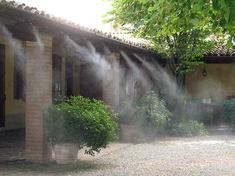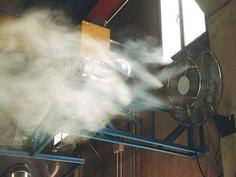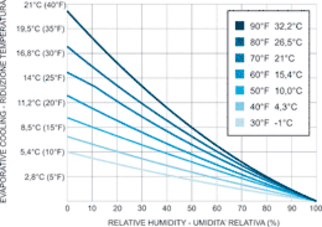COOLING PRINCIPLES
.Misting systems work by forcing water via a high pressure pump and tubing through a brass and stainless steel mist nozzle that has an orifice of about 5 micrometres, thereby producing a micro-fine mist. The water droplets that create the mist are so small that they instantly flash evaporate. Flash evaporation can reduce the surrounding air temperature by as much as 35 °F (20 °C) in just seconds. For patio systems, it is ideal to mount the mist line approximately 8 to 10 feet (2.4 to 3.0 m) above the ground for optimum cooling. Misting is used for applications such as flowerbeds, pets, livestock, kennels, insect control, odor control, zoos, veterinary clinics, cooling of produce, and greenhouses.
Misting fans
A misting fan is similar to a humidifier. A fan blows a fine mist of water into the air. If the air is not too humid, the water evaporates, absorbing heat from the air, allowing the misting fan to also work as an air cooler. A misting fan may be used outdoors, especially in a dry climate.It may also be used indoors with packed party goers.
Small portable battery-powered misting fans, consisting of an electric fan and a hand-operated water spray pump, are sold as novelty items. Their effectiveness in everyday use is unclear.
Relative humidity is the amount of moisture in the air compared to the amount of moisture the air could absorb at the same temperature, is a crucial factor in determining cooling potential. The lower the relative humidity, the more water can be vaporized, and the more heat can be removed.
Evaporative Cooling can be used effectively in most geographical locations. This is because when temperatures reach their peak during the day, humidity is normally at its lowest point.






